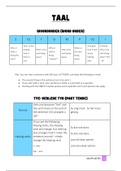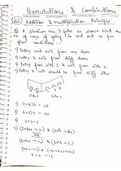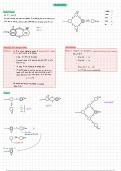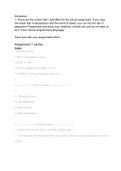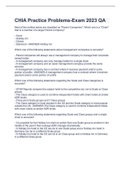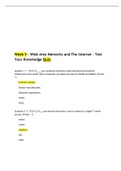Sheetnotes Cognitive Neuroscience
Lecture 1: Learning and Memory
Introduction
Cognitive Neuroscience
- Human behavior
- Task environment
- Neuroprocesses
- Relationshp → measurement techniques fMRI, EEG etc
The aim is to develop neuro-biologically grounded models of mental function and behaviour
Cognition
The set of functions that allow us to perceive external stimuli, to extract key information and hold it
in memory, and ultimately to generate thoughts and actions that help to reach desired goals
Cognitive Science + Neuroscience
• Cognitive science seeks to understand information processing associated with cognitive
functions like perception, memory, and decision making.
• Neuroscience seeks to characterize the structure and function of the nervous system.
• Cognitive neuroscience is a new discipline that applies research methods from neuroscience
to the functions and behaviors studied by cognitive science.
• Cognitive neuroscientists use diverse research methods and experimental paradigms to
develop models of mental function and behavior.
Neuroscience techniques
Spatial and temporal resolution
Combining research methods
, • Convergence: combining results from multiple experimental paradigms to clarify a single
theoretical concept
• Complementarity: different methods provide a different sort of information about brain
function
Combining data: Meta-analysis
Improve the power and precision of experimental findings
• Qualitative meta-analysis
o Examine similarities in results of different studies investigating the same cognitive
function
• Quantitative meta-analysis
o Combine results from multiple studies into a single statistical framework
• Semantic meta-analysis
o Combine studies based on similarity in underlying concepts
The methods of cognitive neuroscience (chapter 2)
Research methods
The starting point for A is the brain. You first start with examining pertubations of the brain, then
you examine how this affects the brain and eventually cognitive functions in a task.
The starting point for B is the cognitive function. You start with examining the performance on a
certain task, then how this affects cognitive functions and eventually how this affects the brain with
brain activity.
Naturally occurring perturbations
One methods cognitive neuroscientists use for studying the interaction of the brain and cognitive
functions is examining how brain lesions affect behavior. Brain damage can be caused by a stroke,
trauma or a disease.
Brain lesions in humans can only be studied postmortum. Which means that the correlation of brain
lesions observed after death and the behavior before death is investigated. However, in alive
animals it is possible to manipulate brain lesions. The advantage of this is that you have more control
over the location and the extent of the damage.
,Example Aging and Alzheimer’s disease: lessons from the Nun study
- Study in group of nuns
o Very homogenous group: no drugs, no alcohol, same housing → little chance of
confounding variables
- Investigated age and scores on Mini Mental State Exam Score → measures cognitive
functions related to Alzheimer’s disease
- Sister Mary scored remarkably high on this test even at the age of 101
- When her brain was examined after her death, it was observed that her brain had severe
damage that was common for Alzheimer’s disease: tangles and plagues.
- Shows that relationship between changes in the brain and cognitive functions are not always
clear-cut
Brain damage
• Size and site of lesions are not under the control of the experimenter
• Substantial inter-individual variation
o in lesions/damage
o in brain activity supporting cognitive functions
• Diaschisis = change of function in portion of the brain connected to a distant but damaged
area might occur
o Brain area do not function in isolation
o Network of brain areas
Dynamics of the brain
Changes in the brain when aging:
- Image on the left 80 years old
- Image on the right 30 years old
These change in structures are not necessarily are accompanied with change in cognitive
performance (e.g., sister mary). We do not receive changes in the brain passively. The brain is
dynamic and can compensate. People who age are able to compensate for fatigue by for example
, putting more effort in the task. This also means that there is no clear one-to-one relationship
between the cognitive function and the structure.
Study of Cabeza:
- Young and old participants performing episodic memory retrieval task
- fMRI
- Results:
o Young participants showed right laterised activation, older participants
showed activaty in both hemisphers of the brain
o Disction in old subjects
▪ Low performance: showed same pattern as young participants →
right laterised activation pattern
▪ High performance: bilateral pattrn → migh illustrate compensation
Recovery of post stroke proximal arm function
Brain images of patients that suffered from functional limitations in arm and elbow after they had a
stroke. These stroke survivors were treated with three to five weeks of rehabilitation. After this they
performed a reflexion task during which brain activation was elicited.
Lecture 1: Learning and Memory
Introduction
Cognitive Neuroscience
- Human behavior
- Task environment
- Neuroprocesses
- Relationshp → measurement techniques fMRI, EEG etc
The aim is to develop neuro-biologically grounded models of mental function and behaviour
Cognition
The set of functions that allow us to perceive external stimuli, to extract key information and hold it
in memory, and ultimately to generate thoughts and actions that help to reach desired goals
Cognitive Science + Neuroscience
• Cognitive science seeks to understand information processing associated with cognitive
functions like perception, memory, and decision making.
• Neuroscience seeks to characterize the structure and function of the nervous system.
• Cognitive neuroscience is a new discipline that applies research methods from neuroscience
to the functions and behaviors studied by cognitive science.
• Cognitive neuroscientists use diverse research methods and experimental paradigms to
develop models of mental function and behavior.
Neuroscience techniques
Spatial and temporal resolution
Combining research methods
, • Convergence: combining results from multiple experimental paradigms to clarify a single
theoretical concept
• Complementarity: different methods provide a different sort of information about brain
function
Combining data: Meta-analysis
Improve the power and precision of experimental findings
• Qualitative meta-analysis
o Examine similarities in results of different studies investigating the same cognitive
function
• Quantitative meta-analysis
o Combine results from multiple studies into a single statistical framework
• Semantic meta-analysis
o Combine studies based on similarity in underlying concepts
The methods of cognitive neuroscience (chapter 2)
Research methods
The starting point for A is the brain. You first start with examining pertubations of the brain, then
you examine how this affects the brain and eventually cognitive functions in a task.
The starting point for B is the cognitive function. You start with examining the performance on a
certain task, then how this affects cognitive functions and eventually how this affects the brain with
brain activity.
Naturally occurring perturbations
One methods cognitive neuroscientists use for studying the interaction of the brain and cognitive
functions is examining how brain lesions affect behavior. Brain damage can be caused by a stroke,
trauma or a disease.
Brain lesions in humans can only be studied postmortum. Which means that the correlation of brain
lesions observed after death and the behavior before death is investigated. However, in alive
animals it is possible to manipulate brain lesions. The advantage of this is that you have more control
over the location and the extent of the damage.
,Example Aging and Alzheimer’s disease: lessons from the Nun study
- Study in group of nuns
o Very homogenous group: no drugs, no alcohol, same housing → little chance of
confounding variables
- Investigated age and scores on Mini Mental State Exam Score → measures cognitive
functions related to Alzheimer’s disease
- Sister Mary scored remarkably high on this test even at the age of 101
- When her brain was examined after her death, it was observed that her brain had severe
damage that was common for Alzheimer’s disease: tangles and plagues.
- Shows that relationship between changes in the brain and cognitive functions are not always
clear-cut
Brain damage
• Size and site of lesions are not under the control of the experimenter
• Substantial inter-individual variation
o in lesions/damage
o in brain activity supporting cognitive functions
• Diaschisis = change of function in portion of the brain connected to a distant but damaged
area might occur
o Brain area do not function in isolation
o Network of brain areas
Dynamics of the brain
Changes in the brain when aging:
- Image on the left 80 years old
- Image on the right 30 years old
These change in structures are not necessarily are accompanied with change in cognitive
performance (e.g., sister mary). We do not receive changes in the brain passively. The brain is
dynamic and can compensate. People who age are able to compensate for fatigue by for example
, putting more effort in the task. This also means that there is no clear one-to-one relationship
between the cognitive function and the structure.
Study of Cabeza:
- Young and old participants performing episodic memory retrieval task
- fMRI
- Results:
o Young participants showed right laterised activation, older participants
showed activaty in both hemisphers of the brain
o Disction in old subjects
▪ Low performance: showed same pattern as young participants →
right laterised activation pattern
▪ High performance: bilateral pattrn → migh illustrate compensation
Recovery of post stroke proximal arm function
Brain images of patients that suffered from functional limitations in arm and elbow after they had a
stroke. These stroke survivors were treated with three to five weeks of rehabilitation. After this they
performed a reflexion task during which brain activation was elicited.

